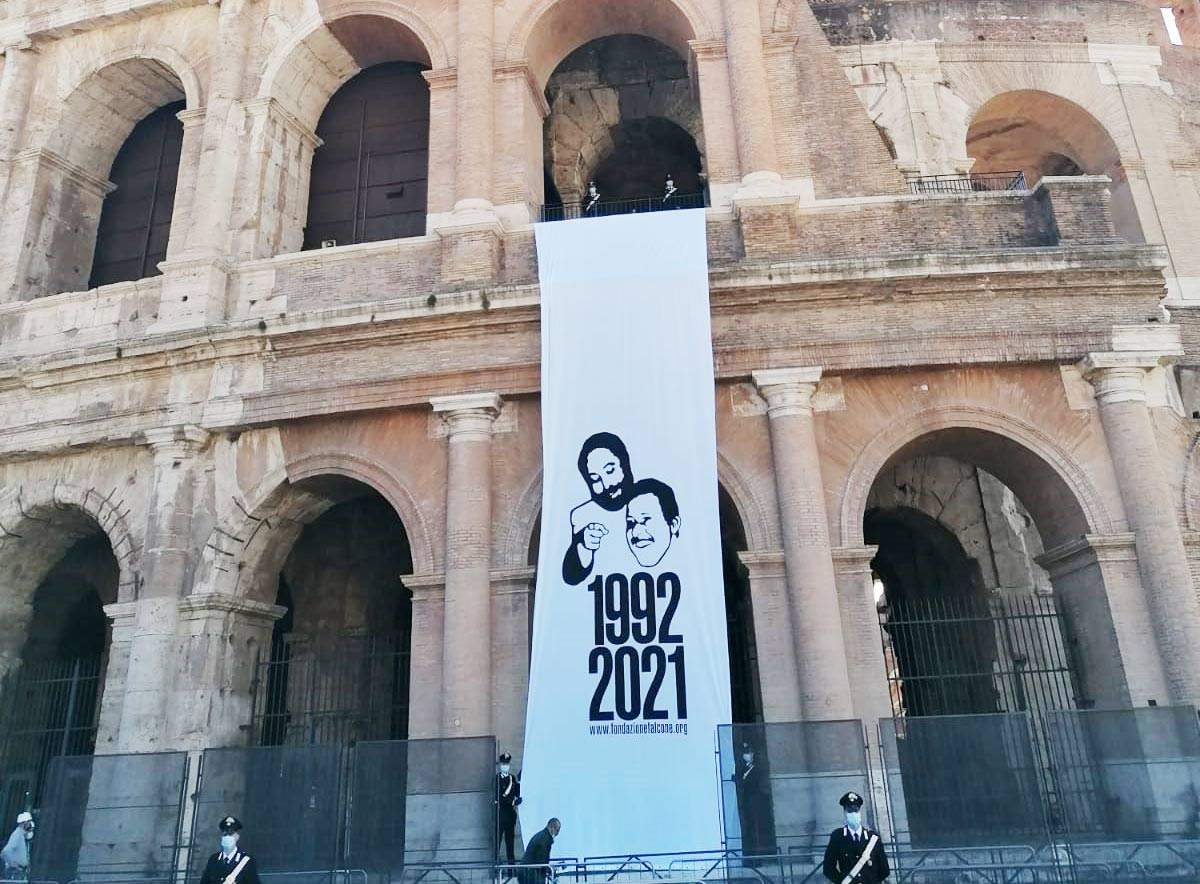A 50-foot-long sheet was hung at the Colosseum against the Mafia
A 15-meter by 4.10-meter sheet hanging from the Colosseum, 15 meters high above the western entrance, against the Mafia: since yesterday, the image of magistrates Giovanni Falcone and Paolo Borsellino stands out on the Flavian Amphitheater in an action that transforms the city into a place of memory, an expression of a new geography of responsibility. This is the idea behind the #unlenzuolocontrolamafia project, which aims to raise awareness of the values of justice and remembrance of those who dedicated their lives to the good of the community. The initiative by the Falcone Foundation and the Ministry of Education, the brainchild of Alessandro De Lisi, is part of Spazi Capaci-Community Capaci, a project to reappropriate urban spaces through art, designed to mark the 29th anniversary of the Capaci Massacre that cost the lives of Judge Giovanni Falcone, his wife Francesca Morvillo and escort officers Rocco Dicillo, Antonio Montinaro and Vito Schifani.
On the Colosseum sheet, designer Carlo Fiore has developed an illustration from a photo of Giovanni Falcone and Paolo Borsellino together, smiling, taken at a convivial moment, a powerful image of life contrasted with the dramatic ones of death linked to Mafia violence. The sheet was chosen as a secular flag that unites the country in a choral cry against mafias and against oppression: and it is precisely the sheets that are the elements of a narrative that links places of art and culture in a path that, starting with the celebrations of the 29th anniversary of the massacres, will culminate in 2023, the 30th anniversary of Cosa Nostra’s massacre strategy culminating with the attacks in Rome, Florence and Milan, with the intention of emphasizing the value of memory as the intangible heritage of the country.
“In some of our country’s symbolic places,” explains Maria Falcone, president of the Falcone Foundation and sister of the magistrate murdered by the Mafia, “sheets with an illustration portraying together Giovanni and Paolo Borsellino, my brother’s friend and colleague, who shared with him rigorous professional commitment and dramatic fate, have been displayed. We found great willingness and sensitivity in all the cultural and civil institutions to which we proposed to join the initiative, and this confirms to us how the memory of Giovanni and Paolo is really part of the national heritage.”
“Immediately and without any hesitation we joined this project,” explains Alfonsina Russo, Director of the Colosseum Archaeological Park. “The Colosseum is a symbol and ambassador in the world of unity among peoples; it is, even before being a historical monument, a place where by reason of its now almost bimillennial history all the races of the world recognize and identify themselves in the sign of peace.” “It is precisely this powerful symbolic function,” he continues, "that makes it a privileged space for any form of awareness-raising against violence and all kinds of discrimination.
A sheet of the same size was placed at the Teatro Massimo in Palermo, while smaller creations-150cm x 240cm-have been displayed in several symbolic places around the country: in Bergamo, at the Tiraboschi Library, in Pisa at Palazzo Gambacorti, in Milan at the Museum of the Twentieth Century, in Turin at Palazzo Civico, in Florence at the Zeffirelli Foundation, in Naples at Palazzo San Giacomo, in Perugia at Palazzo dei Priori, in Reggio Calabria at the Archaeological Museum, in Ragusa at Palazzo di Città, in Ancona at the Palazzo di Giustizia, in Norcia at the Palazzo Comunale, in Bari at the Palazzo di Città, in Trieste at the Prefecture, in Bologna at the Borgo Panigale District Headquarters, in Caserta at the Reggia. In Venice, the sheet will be displayed in all city halls in a sort of “journey” through the city that starts from Ca’ Farsetti in Rialto and moves to the City Hall offices of Mestre, Marghera, Lido, Favaro Veneto, Chirignago Zelarino. Finally, at Asinara, the sheet will be placed at the house where Falcone and Borsellino stayed when, for security reasons, they had to leave Palermo to complete the indictment in the first maxi-trial to the clans.
“We are particularly proud to have been involved by the Falcone Foundation in the celebrations for the 29th anniversary of the Capaci massacre,” says Francesco Giambrone, Superintendent of Palermo’s Teatro Massimo. “A concrete and active participation, which has seen the involvement of our workers from the Brancaccio set design workshop, custodians of a tradition of theatrical craftsmanship of great prestige, engaged in the realization of the ’Sheet of Memory’ that will be displayed at the Colosseum as well as in many other places of art and beauty in our country, including precisely the Teatro Massimo. A testimony of memory that the Teatro Massimo continues to cultivate in the memory of the sacrifice of Giovanni Falcone, Paolo Borsellino and all the women and men who fell like them to defend the dignity of being citizens free from the yoke of the Mafia.”
The project was carried out thanks to the fundamental contribution of the Carabinieri General Command, which has always, with the Falcone Foundation and Italy’s Territorial Commands, been committed to fighting organized crime and promoting the culture of legality. Today, in four Italian cities - Rome, Palermo, Florence and Milan, the scene of the Mafia massacres of 1992 and 1993, the display of the sheet took place during a ceremony featuring the Carabinieri Fanfare.
 |
| A 50-foot-long sheet was hung at the Colosseum against the Mafia |
Warning: the translation into English of the original Italian article was created using automatic tools. We undertake to review all articles, but we do not guarantee the total absence of inaccuracies in the translation due to the program. You can find the original by clicking on the ITA button. If you find any mistake,please contact us.




























